Key Seasonal Considerations For Commercial Exterior Paint: What You Need To Be Enlightened About
Key Seasonal Considerations For Commercial Exterior Paint: What You Need To Be Enlightened About
Blog Article
Produced By-Regan Rosendal
When you're planning an industrial exterior painting project, seasonal variables can make or break your results. You'll intend to consider exactly how temperature and humidity impact paint application and drying times. Choosing the best period can ensure your paint adheres appropriately and lasts longer. Yet which periods are really the very best for this sort of job? Allow's explore the crucial elements that can affect your task's success.
The Effect of Temperature Level on Paint Application
When you're preparing a business external painting project, the temperature level can dramatically impact exactly how well the paint sticks and dries.
Preferably, you wish to repaint when temperature levels range between 50 ° F and 85 ° F. If it's as well cold, the paint might not heal correctly, resulting in concerns like peeling off or breaking.
On Get the facts , if it's too hot, the paint can dry as well promptly, avoiding correct attachment and leading to an uneven surface.
You need to additionally take into consideration the time of day; early morning or late afternoon provides cooler temperature levels, which can be much more beneficial.
Constantly inspect the supplier's recommendations for the certain paint you're utilizing, as they typically give guidance on the suitable temperature level range for optimum outcomes.
Humidity and Its Result on Drying Times
Temperature level isn't the only environmental aspect that affects your business outside painting job; humidity plays a substantial function too. High moisture levels can decrease drying out times significantly, impacting the general high quality of your paint task.
When the air is saturated with moisture, the paint takes longer to cure, which can bring about issues like inadequate adhesion and a greater risk of mildew development. If you're repainting on a specifically damp day, be gotten ready for extensive wait times in between coats.
It's critical to check neighborhood weather conditions and strategy accordingly. Ideally, go for moisture levels in between 40% and 70% for optimal drying.
Keeping these factors in mind guarantees your task stays on track and provides an enduring finish.
Best Seasons for Commercial Outside Paint Projects
What's the best time of year for your industrial exterior painting tasks?
Spring and very early fall are normally your best bets. During these periods, temperature levels are mild, and humidity levels are commonly reduced, creating excellent conditions for paint application and drying.
Prevent summer season's intense heat, which can create paint to dry as well rapidly, causing inadequate attachment and finish. In a similar way, wintertime's cool temperatures can prevent correct drying and treating, taking the chance of the long life of your paint job.
Go for contract painters near me with temperatures in between 50 ° F and 85 ° F for optimal results. Remember to check the neighborhood weather prediction for rainfall, as damp conditions can wreck your task.
Planning around these factors guarantees your painting task runs efficiently and lasts much longer.
Final thought
Finally, preparing your industrial outside painting jobs around seasonal considerations can make a considerable difference in the end result. By scheduling job during the excellent temperature levels and moisture degrees, you'll ensure far better adhesion and drying times. Remember to watch on neighborhood weather report and pick the right time of year-- springtime and very early autumn are your best options. Taking these steps will certainly help you attain a resilient and expert surface that lasts.
